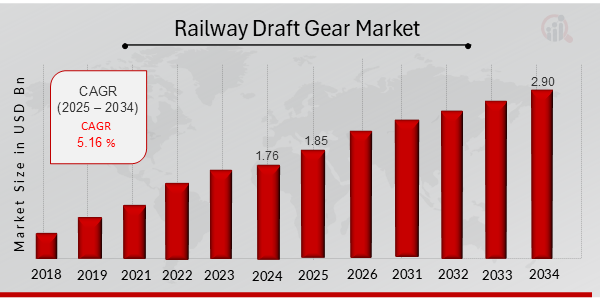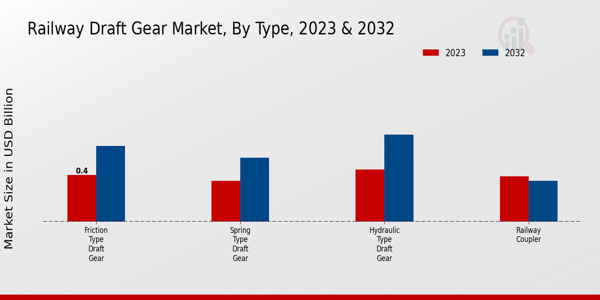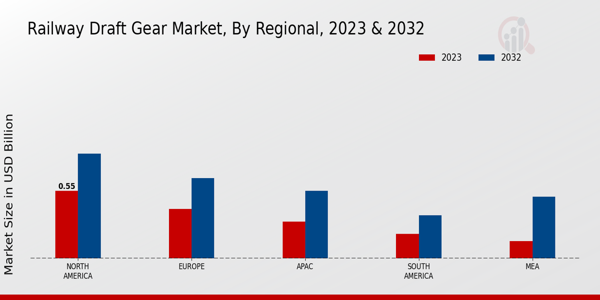Railway Draft Gear Market Overview:
As per MRFR analysis, the Railway Draft Gear Market Size was estimated at 1.76 (USD Billion) in 2024. The Railway Draft Gear Market Industry is expected to grow from 1.85 (USD Billion) in 2025 to 2.90 (USD Billion) till 2034, at a CAGR (growth rate) is expected to be around 5.16% during the forecast period (2025 - 2034).
Key Railway Draft Gear Market Trends Highlighted
The global railway draft gear market is experiencing significant growth due to various market drivers. One of the main factors is the increasing investment in rail infrastructure worldwide. Governments are focusing on improving transportation efficiency, which drives the demand for advanced equipment such as draft gears.
Moreover, the rise in freight transportation and the need for sustainable mobility solutions contribute to the market's expansion. Another key driver is the push for safety and reliability in rail operations, prompting the adoption of innovative draft gear technologies that enhance vehicle stability and reduce maintenance costs.
There are numerous opportunities to be explored in the railway draft gear sector. The growing demand for lightweight materials and advanced engineering solutions presents avenues for companies to innovate and offer products that lead to better performance.
Additionally, as countries invest in high-speed rail projects, the need for specialized draft gear that can accommodate higher speeds and dynamic loads becomes apparent. Collaboration with technology providers can also lead to significant advancements that enhance performance and durability.
The market for aftermarket services is likely to see growth as existing rolling stock is retrofitted with new technologies to improve efficiency and safety. In recent times, the emphasis on sustainability and reducing carbon emissions has influenced the railway draft gear market.
This trend has led manufacturers to focus on eco-friendly materials and designs that can help minimize the environmental impact of rail operations. Furthermore, the integration of smart technologies into railway systems has started to reshape the market landscape.
These advancements promote efficiency and enable real-time monitoring of equipment performance, ensuring better operational reliability. As the industry continues to evolve, adaptability and innovation will be crucial for companies aiming to succeed in the competitive railway draft gear market.

Source: Primary Research, Secondary Research, MRFR Database and Analyst Review
Railway Draft Gear Market Drivers
Increasing Investments in Railway Infrastructure
The ongoing investment in railway infrastructure development is a significant driver for the global railway draft gear market. Governments and private organizations worldwide are increasingly recognizing the critical role that rail transport plays in reducing traffic congestion, lowering transportation costs, and providing a more sustainable alternative to road transport.
This heightened focus on enhancing the efficiency and capability of railway services leads to substantial investments in upgrading existing rail networks and constructing new ones. Such initiatives not only improve the overall travel experience for passengers but also facilitate the movement of goods, thereby stimulating economic growth.
Investments in railway infrastructure also led to the modernization of various railway components, which include the essential draft gear systems that play a vital role in ensuring the safety and smooth operation of trains.
Therefore, this trend is expected to foster steady growth in the global railway draft gear market, as an upgraded railway system necessitates the procurement of advanced draft gear technologies to enhance the performance, flexibility, and safety of rail operations.
Growing Demand for Freight Transport
The rising demand for efficient and reliable freight transport is a major driver for the global railway draft gear market. As industries expand and global trade increases, there is a growing need for effective transportation solutions that can handle larger volumes of goods.
Railways offer a cost-effective and environmentally friendly method for freight transport, leading many businesses to shift towards rail logistics. The enhanced focus on reducing carbon footprints by adopting greener transportation options further bolsters this trend.
Technological Advancements in Draft Gear Systems
Technological innovations are driving the evolution of draft gear systems in the railway sector, significantly influencing growth in the global railway draft gear market.
Continuous research and development efforts are leading to the introduction of advanced materials and designs that improve the efficiency and durability of draft gear systems. These innovations are aimed at increasing operational performance and reducing maintenance costs, making railway transport more appealing to operators and manufacturers alike.
Railway Draft Gear Market Segment Insights:
Railway Draft Gear Market Type Insights
The global railway draft gear market is experiencing significant growth, supported by a diverse range of types that cater to various operational requirements within the railway industry. The market segmentation includes four key types: friction type draft gear, spring type draft gear, hydraulic type draft gear, and railway coupler, each serving unique functionalities and operational efficiencies.
The friction type draft gear occupied a notable position, reported at 0.4 USD billion in 2023 and projected to rise to 0.65 USD billion in 2032, highlighting its enduring popularity and effectiveness in energy absorption and shock attenuation, crucial for smooth railway operations.
Following closely, the spring type draft gear, valued at 0.35 USD billion in 2023, is anticipated to grow to 0.55 USD billion by 2032, demonstrating its significant application in providing necessary flexibility and resilience in rail joints. This segment's adaptability to various load requirements accentuates its importance in maintaining operational stability across diverse railway networks.
The hydraulic type draft gear was also pivotal, starting with a market value of 0.45 USD billion in 2023 and expected to reach 0.75 USD billion by 2032. This type is particularly advantageous due to its superior energy absorption capabilities, which enhance the overall safety and efficiency of train operations, thereby contributing to its growing market value.
Lastly, the railway coupler, although projected to decline slightly from 0.39 USD billion in 2023 to 0.35 USD billion by 2032, held significance in connecting rolling stocks with ease, showcasing its integral role in the rail industry's operational framework.
Understanding the nuances of this global railway draft gear market segmentation reveals emerging trends and growth drivers, such as the rising demand for efficient and reliable railway systems and technological advancements that enhance the performance of these types.
Collectively, these insights provide a comprehensive understanding of the global railway draft gear market dynamics, emphasizing the critical roles that each type plays in advancing railway functionality and safety.

Source: Primary Research, Secondary Research, MRFR Database and Analyst Review
Railway Draft Gear Market Application Insights
The global railway draft gear market plays a pivotal role in enhancing the efficiency and safety of train operations across various types of rail transport. The application segment comprises key areas such as freight trains, passenger trains, high-speed trains, and light rail transit, each significantly contributing to the overall market growth.
Freight trains are essential for transporting goods across long distances, leading to substantial demand for robust draft gear systems that facilitate smoother operations. Passenger trains maintain a crucial role in urban transportation, reflecting trends toward sustainable travel, which drives the need for advanced draft gear technologies.
High-speed trains represent a growing segment, emphasizing the necessity for superior performance and reliability, while light rail transit systems cater to urban commuters, thus addressing the increasing focus on public transportation solutions.
Collectively, these applications shape the global railway draft gear market segmentation, presenting various growth opportunities and challenges driven by technological advancements and the ongoing push for eco-friendly transit solutions.
The projected growth trajectory indicates a healthy market landscape, making it an area of interest for further exploration and investment in the railway sector.
Railway Draft Gear Market Material Insights
The Material segment plays a crucial role in this expansion as it encompasses various materials integral to draft gear performance and reliability. Steel remains a dominant choice due to its strength and durability in high-stress environments, making it essential for heavy-duty railway applications.
Composite materials are gaining traction for their lightweight and corrosion-resistant properties, contributing to enhanced fuel efficiency and lower maintenance costs.
Plastic, while perceived as less traditional, is valued for its cost-effectiveness and adaptability in specific applications. Aluminum is also significant, offering a balance of lightweight design and strength, which is crucial for improving overall vehicle performance.
These materials contribute to the overall global railway draft gear market revenue by enhancing safety, reliability, and efficiency while responding to evolving technological demands and sustainability goals.
The market statistics indicate a growing inclination towards innovative materials, creating opportunities for advancements and competition among manufacturers while addressing future challenges in the railway industry.
Railway Draft Gear Market End Use Insights
The global railway draft gear market showcases a diversified structure across its end-use segment, including public transport, logistics and freight, and tourism. Public transport is a significant contributor, driven by ongoing urbanization and the demand for efficient mass transit solutions.
Logistics and freight play a critical role due to the increasing e-commerce activities and the need for reliable transportation of goods, which drives innovation in draft gear systems. Meanwhile, the tourism sector is expanding rapidly, encouraging investments in rail infrastructure to enhance travel experience, highlighting the importance of well-maintained railway systems.
Collectively, these areas represent major contributors to the overall growth potential of the global railway draft gear market, reflecting evolving trends in transportation, such as sustainability and modernization. The segment demonstrates resilience against challenges while uncovering opportunities for advancements in technology and infrastructure, aligning with global transportation needs.
Railway Draft Gear Market Regional Insights
In the regional segmentation, North America emerged as a major player, valued at 0.55 USD billion in 2023, with a strong growth trend anticipated to reach 0.85 USD billion by 2032, indicating a majority holding of the market share due to robust rail infrastructure.
Europe followed, holding a significant share valued at 0.4 USD billion in 2023, projected to rise to 0.65 USD billion, driven by increasing investments in railway systems. The APAC region, valued at 0.3 USD billion in 2023 and expected to expand to 0.55 USD billion, reflected a growing demand for modern rail solutions, marking it as an important contender.
South America, while smaller, showed potential growth from 0.2 USD billion to 0.35 USD billion, largely due to emerging markets. The Middle East and Africa (MEA) stood at 0.14 USD billion and 0.5 USD billion by 2032, reflecting rising railway development initiatives.
Overall, these insights into the global railway draft gear market revenue illustrate diverse regional dynamics, with significant investment driving future growth.

Source: Primary Research, Secondary Research, MRFR Database and Analyst Review
Railway Draft Gear Market Key Players and Competitive Insights:
The global railway draft gear market is characterized by a diverse landscape of competitors that provide comprehensive solutions for locomotive coupling systems. As the demand for efficient railway infrastructure continues to grow, several key players have established themselves as leaders in this segment, focusing on enhancing the safety, reliability, and performance of railway operations.
Competitive dynamics are shaped by technological advancements, sustainability practices, regulatory changes, and the ongoing modernization efforts within the rail industry. Players also strive to innovate and differentiate their offerings, ensuring cohesive integration with existing systems while catering to the evolving demands of customers
This landscape reflects intense competition characterized by strategic partnerships, mergers, acquisitions, and a robust focus on research and development. Schneider Electric possesses a formidable presence in the global railway draft gear market, leveraging its extensive expertise in energy management and automation solutions.
The company is recognized for its commitment to developing high-performance draft gear systems that ensure safety and reliability in railway operations. Schneider Electric's strength lies in its innovative technologies that optimize operational efficiency while minimizing energy consumption.
Its ability to customize solutions tailored to specific client needs further enhances its competitive edge. Schneider Electric's integrated approach in combining hardware, software, and services allows it to offer a comprehensive suite of products that meet the rigorous demands of modern rail systems.
The brand's robust supply chain capabilities and global presence enable it to serve various markets effectively, positioning it well against competitors. Voith is another prominent entity within the global railway draft gear market, known for its advanced engineering solutions that bolster railway transportation efficiency and safety.
The company excels in delivering cutting-edge draft gear technologies that enhance shock absorption and improve the overall operational performance of trains. Voith's strength is deeply rooted in its research and development efforts, which facilitate the development of innovative products that align with industry standards and specific customer requirements.
With a long-standing reputation for quality and reliability, Voith has built a loyal customer base across various regions. Its dedicated focus on sustainability practices and energy-efficient solutions distinguishes Voith from its competitors, aligning with the industry's shift towards more environmentally friendly operations.
Through strategic partnerships and collaborations, Voith continues to expand its market footprint and enhance its product offerings in the railway draft gear sector.
Key Companies in the railway draft gear market Include:
- Schneider Electric
- Voith
- KnorrBremse
- Hepworth Railway
- Stadler Rail
- Pandrol
- Bombardier
- Siemens
- Alstom
- CAF
- Bogie Systems
- Wabtec
- Mitsubishi Heavy Industries
- Amsted Rail
- Toshiba
Railway Draft Gear Market Developments
The global railway draft gear market is currently experiencing significant developments, with companies like Siemens and Alstom focusing on innovation and sustainability to enhance their competitive positioning. Recently, Schneider Electric has expanded its product offerings to include advanced draft gear solutions that improve operational efficiency.
Voith and KnorrBremse have been optimizing their manufacturing processes to meet rising demand due to increased rail infrastructure investments worldwide.
In terms of mergers and acquisitions, Bombardier is reportedly exploring strategic partnerships to strengthen its market presence, while Mitsubishi Heavy Industries has been involved in discussions regarding potential alliances with Bogie Systems for technological advancements.
The market is witnessing a growth surge, largely driven by the increasing focus on electrification and modernization of rail networks, benefiting companies like Pandrol and CAF as they develop cutting-edge rail technologies.
Companies like Wabtec are also seeing valuation increases due to partnerships aimed at enhancing safety and performance in rail transport, reflecting a broader trend toward innovation within the industry. The collective growth among these firms is shaping the global railway draft gear market landscape as stakeholders recognize the critical need for investment in robust railway systems globally.
Railway Draft Gear Market Segmentation Insights
- Railway Draft Gear Market Type Outlook
- Friction Type Draft Gear
- Spring Type Draft Gear
- Hydraulic Type Draft Gear
- Railway Coupler
- Railway Draft Gear Market Application Outlook
- Freight Trains
- Passenger Trains
- High-Speed Trains
- Light Rail Transit
- Railway Draft Gear Market Material Outlook
- Steel
- Composite Materials
- Plastic
- Aluminum
- Railway Draft Gear Market End Use Outlook
- Public Transport
- Logistics and Freight
- Tourism
- Railway Draft Gear Market Regional Outlook
- North America
- Europe
- South America
- Asia Pacific
- Middle East and Africa
| Report Attribute/Metric |
Details |
|
Market Size 2024
|
1.76 (USD Billion)
|
|
Market Size 2025
|
1.85 (USD Billion)
|
|
Market Size 2034
|
2.90 (USD Billion)
|
|
Compound Annual Growth Rate (CAGR)
|
5.16% (2025 - 2034)
|
|
Report Coverage
|
Revenue Forecast, Competitive Landscape, Growth Factors, and Trends
|
|
Base Year
|
2024
|
|
Market Forecast Period
|
2025 - 2034
|
|
Historical Data
|
2019 - 2023
|
| Market Forecast Units |
USD billion |
| Key Companies Profiled |
Schneider Electric, Voith, KnorrBremse, Hepworth Railway, Stadler Rail, Pandrol, Bombardier, Siemens, Alstom, CAF, Bogie Systems, Wabtec, Mitsubishi Heavy Industries, Amsted Rail, Toshiba |
| Segments Covered |
Type, Application, Material, End Use, Regional |
| Key Market Opportunities |
Rising demand for freight transport, Growing investment in rail infrastructure, Technological advancements in materials, Expansion of urban transit systems, Increased focus on safety regulations |
| Key Market Dynamics |
Technological advancements in materials, Increasing rail network infrastructure, Growing demand for freight transport, Stringent safety regulations, Rise in railway modernization projects |
| Countries Covered |
North America, Europe, APAC, South America, MEA |
Frequently Asked Questions (FAQ) :
The global railway draft gear market is expected to be valued at 2.90 USD billion by 2034.
The expected CAGR for the global railway draft gear market from 2025 to 2034 is 5.16%.
In 2023, North America held the largest market share in the global railway draft gear market, valued at 0.55 USD billion.
The Friction Type Draft Gear segment is expected to be valued at 0.65 USD billion in 2032.
Key players in the global railway draft gear market include Schneider Electric, Voith, KnorrBremse, and Bombardier.
The Hydraulic Type Draft Gear is expected to be valued at 0.55 USD billion in 2024.
The APAC region is projected to reach a market size of 0.55 USD billion by 2032.
The Spring Type Draft Gear market is expected to be valued at 0.55 USD billion in 2032.

















